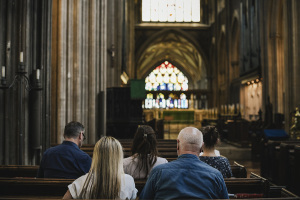Placing ISIS' Persecution of the Copts in Context

Martyrdom was not new to them or their people. For nearly two thousand years, their Church had prided itself as being the Church of the Martyrs. If martyrdom was a central feature of the early church, it had become the hallmark of its identity in Egypt. Even as early as the third century a quote attributed to Tertullian declared: "If the martyrs of the whole world were put on one arm of the balance and the martyrs of Egypt on the other, the balance would tilt in favor of the Egyptians". From the blood of Saint Mark the Evangelist shed in Alexandria in 68 AD the river continued to flow, each century adding its martyrs. The names of the persecutors had changed; Romans and Byzantines and Arabs, Emperors and Caliphs and Kings. Each had contributed his share, each had attempted to end their faith, and each in turn had failed.
The horrific murder of twenty Copts and a Ghanaian Christian at the hands of ISIS in Libya in February 2015 was followed by swift condemnations from around the world. Most world leaders described the victims the way they identified themselves, as Coptic Christians. Pope Francis recognized that they had been "killed simply for the fact that they were Christians", and that "their blood confesses Christ". Their murderers certainly concurred. ISIS had searched the workers' compound looking for Copts. "People of the cross" they named them in the video. Their beheading was in revenge for Kamilia Shehata; a wife of a Coptic priest, who had briefly disappeared in July 2010 before returning to her family. Soon her cause became a rallying cry for Egyptian Salafis convinced that she had been prevented from converting to Islam and held against her will by the church. Demonstrations by Salafis soon gave way to action by jihadis. Iraqi Christians were the first victims, with the horrific attack later that year on the Our Lady of Salvation Church in Baghdad leaving 58 dead. Even then, the predecessors of ISIS had championed Kamilia's cause. The Two Saints Church bombing in Alexandria that left twenty-three Copts dead on New Year's Eve was probably related.
The White House dissented against the Coptic identity of those killed by ISIS, with a statement describing the victims as " Egyptian citizens". Even in their deaths, their identity was to be buried. For unbeknownst to the White House, they were merely echoing a deep Egyptian tradition that sought to bury any trace of the Coptic identity, despite paradoxically never ceasing from viewing Copts as such.
Nationalism, like all modern inventions, was imported from Europe. The rapid modernization of Egypt in the 19th century initially attempted to sidestep ideologies altogether. This was not to be. The question of identity soon stormed the lives of Egypt's emerging elite. Who are we? Ottomans, Muslims, Egyptians, Arabs; each label carried the day for a while as Egypt searched for its place under the sun. It was not, however, the Muslim and Coptic identities that initially clashed, but Egyptian nationalism. Both the Egyptian and Coptic identities were born at the same time, both owed much of their formation to the European discovery and fascination with Egypt's Pharaonic past, and both claimed that past for their imagined nation. The clash was inevitable.
Enchanted with European ideas, Ahmed Lutfi el-Sayed and the other early founders of Egyptian nationalism had abandoned Islam as a basis for politics and the nation. Their imagined Egypt was one homogenous nation that had maintained a Pharaonic core throughout the centuries. Yet their formulation was inherently contradictory. According to the National Unity discourse they advocated Egypt was a homogenous nation formed by two distinct elements, which had lived in perfect harmony throughout the centuries: Muslims and Copts. To belong to the Egyptian nation, a Copt was thus required to shed his Copticness while paradoxically never allowed to escape it. It was not Copts as individuals that were to be banished from the public square, but Coptic identity.
For the Copts, liberated from the shackles of Dhimmitude by modernity, the Pharaonic past was exclusively theirs. They were the true descendants of the pharaohs, untainted by bedouin waves, buying this distinction by paying the jizyah instead of converting. They had lost their language to time and persecution, but not their church, which had stood as a rock in front of wave after wave of persecution. It had not bent. It had not been broken. Forever persecuted, but never destroyed.
In a region that viewed identity as a hat, with men incapable of wearing two at the same time, the clash between both claims to exclusivity was unavoidable. Lutfi and his followers were not religious fanatics but instead champions of liberalism. They had a Coptic problem, but no issue with some of their fellow citizens being Christian. It was the notion that Copts formed a distinct nation that they tried to suppress for it stood in contradiction to the imagined Egypt they invented. There could be no separate identity or nation within Egypt's borders. If Copts claimed they were the true descendants of the Pharaohs that undermined the very basis of Egyptian nationalism. Coptic claims of persecution and demands for equality undermined the nationalist narrative and only served Western attempts to divide Egypt and thus had to be suppressed. It would only be a downhill road from that point.
The liberal nationalists are of a bygone era, but their attempt to suppress the Coptic identity is not. Arab nationalist and leftists carried the banner for a time, whilst Islamists happily carry it today. However, beyond political ideologies, the banishment of any public manifestation of Christianity or Copticness from the public square has become the norm. Three weeks after the Libya massacre, police in a village in Samalut failed to convince the local residents to allow a church to be built despite it having all the necessary permits. The local residents did not want to kill their Coptic neighbors nor did they object to them praying. What the mob demanded was that this place of worship be devoid of any outward symbols. If Copts agreed that their church have no bells, dome, crosses, or tower, and that its door should be on a side street and not the main one, they could pray in peace.
Yet despite all attempts to suppress it, the Coptic identity is experiencing an amazing flourishing. Banished from the public square, that identity flourishes inside the walls of churches and in the hearts and minds of Copts. It flourishes in Coptic communities in Egypt as well as those in New Jersey, Mississauga, Sydney and other cities in the diaspora. The martyrs in Libya, who died with the words "Lord Jesus Christ" on their lips, have now occupied their place among the long list of Coptic martyrs. A new feast, February 15th, has been added to the Calendar of the Martyrs, as the Coptic calendar is called, and their icon, produced by a Coptic digital iconographer in Virginia, will soon adorn Coptic Churches across the globe. "The blood of martyrs is the seed of the Church," declared Tertullian. 1800 years later, it still is and for Copts, it is also the seed of the Coptic identity.
This column was originally published at the Tony Blair Foundation.





























